
What are Mycotoxins?
Mycotoxins are secondary metabolites produced by fungi in the plants before or after harvest. A large percentage of the agricultural production worldwide is contaminated by at least one mycotoxin.
Due to the economic and health impacts, the interest in fungi and Mycotoxins is enormous.
Danger in animal feed
Mycotoxins can contaminate all kinds of raw materials and cause significant damage to animals health and production.
Therefore, Mycotoxins are included within the group of undesirable substances in animal feed regulated by the EU Directive 2002/32 EC.

Sterigmatocystin
Ochratoxin A
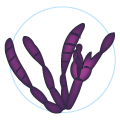
Zearalenones
Fumonisins
Fusarium
Monilifomin
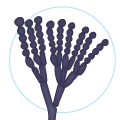
Citrinin
Ochratoxin A

Tenuazonic acid


Classification of Mycotoxins
according to their origin

PRE HARVEST Mycotoxins
Moulds invade grains before or after the harvest (always before the threshing machine).
Includes different species requiring high levels of moisture in the grain (20-22%).
Produced by the genera Fusarium (trichothecenes, zearalenone, fumonisins), Claviceps and Neotyphodium (ergot alkaloids).
POST HARVEST Mycotoxins
Produced by genera such as Aspergillus, which is primarly responsible for the production of aflatoxins, and by Penicillium, Monascus or Mucor on forages and silages.

PRE HARVEST Mycotoxins
FUSARIUM
Fusarium is a genus of mould that is a part of the field flora (phytopathogenic substrates, living plants) and intermediate flora (substrates of freshly picked and still wet cereals). This mould vegetates at a temperature between 6ºC and 40ºC, with an optimum between 18ºC and 30ºC. It is aerobic and, in general, it needs water activity (aw) higher than 0.88 to grow and proliferate and higher than 0.91 to produce Mycotoxins. Zearalenone is produced at temperatures between 10-14ºC.
Fusarium Mycotoxins affecting the livestock are: Zearalenone (ZEN) Fumonisin B1 (FB1) Trichothecenes (vomitoxin or deoxynivalenol (DON), T-2 toxin, and diacetoxyscirpenol (DAS)).
Zearalenone
Zearalenone (ZEN) is essentially produced by:
Fusarium roseum, F.tricinctum, F.roseum “Culmorum”, F.roseum“Equiseti”, F.roseum “Gibbosum”, F.roseum “Graminearum”, F.oxysporum, F.moniliforme
Toxins concentrations
Fusarium roseum produces the highest concentrations of zearalenone (3000-15000 mg/Kg), while Fusarium moniliforme produces smaller amounts of zearalenone raging from 1-19 mg/Kg.
There are 16 different derivatives of zearalenone of which the most important and toxic is zearalenone, followed by zearalenol.
Raw materials affected
As a natural contaminant, zearalenone can be found in corn and its by-products, barley, wheat, oats, sorghum, sesame seed, rapeseed, hay and silage.
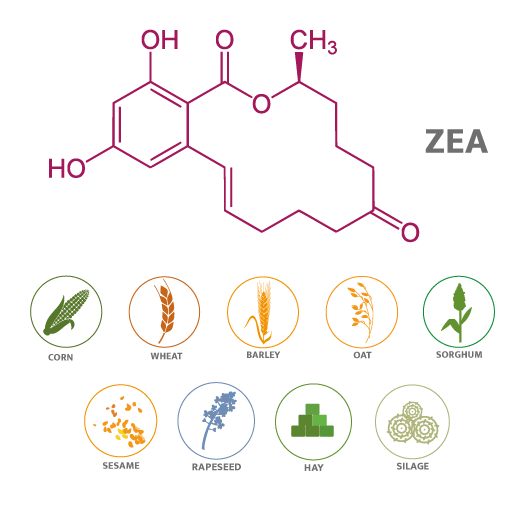
Fumonisins
Fumonisins are essentially produced by Fusarium moniliforme.
There are 6 types of fumonisins: B1, B2, B3, B4, A1 and A2. However, the most frequent and the most important ones are Fumonisin B1 (FB1) and Fumonisin B2 (FB2) can be found as a natural contaminant in cereals (preferably in corn and corn by-products).
Raw materials affected
Fumonisin B1 and B2 can be found as a natural contaminant in cereals, preferably in corn and corn by-products.
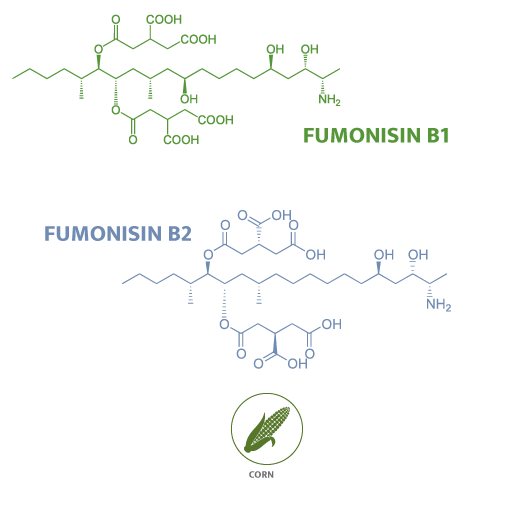
Trichothecenes
Trichothecenes are essentially produced by:
Fusarium tricinctum F.nivale, F.roseum, F.graminearum, F.solani, F.oxysporum, F.lateritium, F.sporotrichioides, F.rigidiusculum, F.episphaeria, F.poae.
Other moulds, can also produce trichothecene toxins, such as: Cephalosporium crotocigenum, Myrotecium verrucaria, Stachybotrys atra, Calonectria nivalis, Trichoderma viride, Tricotecium roseum, Gibberella saubinetti.
Toxins concentrations
There are more than 40 derivatives of trichothecenes. However, the most frequent natural contaminants are as follows: Toxin T-2 Diacetoxiscirpenol(DAS) Vomitoxin or deoxynivalenol(DON) Nivalenol .
Trichothecenes are named after the tetracyclic skeleton 12,13-epoxytrotec-9-ene, contained in their molecule.
Raw materials affected
As natural contaminants, trichothecene toxins can be found in cereals: corn and corn by-products, barley, sorghum, oats, wheat and wheat by-products, rice, rye and millet.
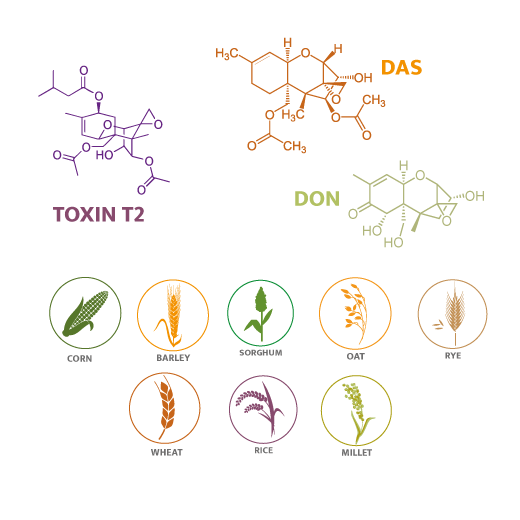

PRE HARVEST Mycotoxins
CLAVICEPS
Ergot (Claviceps purpurea) is a parasitic fungus of the Claviceps genus that contains more than fifty species.
All of them can affect a wide variety of cereals and herbs, although rye is their most common host.
The most parasitized cereal is rye, hence its name “ergot rye”, although it can also parasitize wheat, oats, barley, grass, ray grass, millet.
Infestations of this fungus cause the reduction in quality and quantity of grains and hay, and if these infected crops are used to feed livestock, they have negative effects on their production as well. The most affected species is bovine.


POST HARVEST Mycotoxins
Penicillium Mycotoxins
Ochratoxins
Ochratoxins are produced by Aspergillus ochraceus, Penicillium viridicatum and Penicillium cyclopium.
There are in total 7 types of ochratoxins, out of which the most toxic is ochratoxin A (OTA).
As a natural contaminant, ochratoxin A can be found in cereals (essentially, in barley and rice), cereal products, peanut flour and in a variety of food intended for human consumption, such as raw coffee beans, legumes, cheese, smoked meats (ham, bacon and sausages).
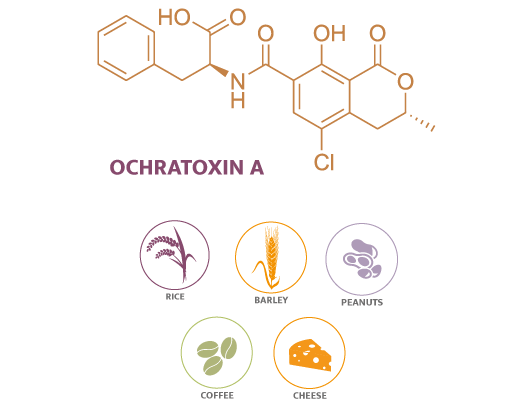

POST HARVEST Mycotoxins
Aspergillus Mycotoxins
Aflatoxins
Essentially produced by Aspergillus flavus and Aspergillus parasiticus. There are so far 18 types of aflatoxins of which the most toxic are Aflatoxin B1 (AFB1) and Aflatoxin M1 (AFM1) (the letter is a metabolic derivative of aflatoxin B1).
These are followed, in order from higher to lower toxicity, by aflatoxins G1 (AFG1), M2 (AFM2), B2 (AFB2) and G2 (AFG2) (aflatoxin M2 is a metabolic derivative of aflatoxin B2).
As natural contaminants, Aflatoxins can be found in cereals (essentially, in corn, wheat, sorghum and rice) and cereal products, oil-seed turtles (cotton, peanut, rapeseed, coconut, palm kernel and sunflower), oil plants, cassava and in a variety of food intended for human consumption, such as cereal products, nuts, sausage products, spices, wine, legumes, fruits, milk and dairy products.
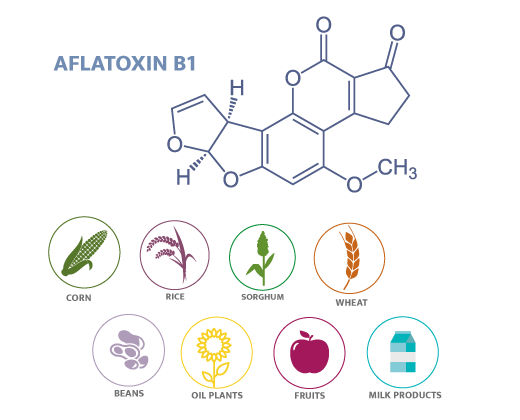
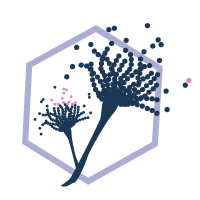








 Micotoxicosis prevention
Micotoxicosis prevention